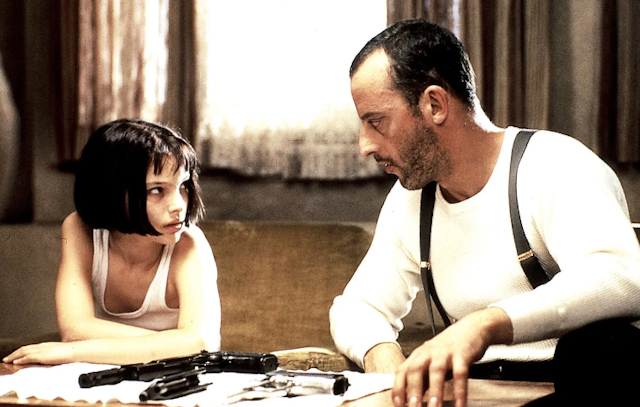This year marks the 25th anniversary of Luc Besson’s controversial thriller Léon: The Professional – and a special director’s cut has been released to mark the event. In 1995, the film caused a stir on its release over its portrayal of the relationship between the two main characters, the loner hitman Léon and his girl apprentice Mathilda.
The representation of Mathilda as a sexually precocious pre-teen was shocking to both viewers and critics, but the film made stars of both actors, Natalie Portman and Jean Reno, and catapulted Besson into mainstream Hollywood.
Adolescent girls’ stories have long been presented in terms of their sexual precociousness. Yet the history of youth can offer insights into girls’ culture that provides an alternative view to the more common perspective of the male gaze.
In film theory, the male gaze provides a view of the world through the eyes of straight men, since they tend to dominate positions within the film and TV industry. But looking at the nature of girls’ culture, which involves adapting adult conventions to suit their needs, can provide a radical rereading of girlhood.
Looking at Léon
Though Besson’s film was critically acclaimed and in many ways has stood the test of time, its representation of girlhood has long been seen as problematic – and still jars.
Léon presents the story of Mathilda (played by a 12-year-old Portman in her debut role), who is orphaned when her family is murdered and seeks refuge with her neighbour Léon. Mathilda tells Léon that she is 18, though she is clearly prepubescent. Due to her traumatic formative experiences, she believes that she has “finished growing up” and “just getting older”. Over time the two become close as Mathilda becomes Léon’s protégé. Eventually, Mathilda tells Léon that she loves him, and and that she wants to “have it” with him.
In a scene that reinforces her precociousness, Mathilda dresses up as a series of celebrities, impersonating Madonna, Marilyn Monroe and Charlie Chaplin for Léon. The scene wasn’t rehearsed, so that Reno’s response would be one of genuine surprise when Portman croons Like a Virgin and Happy Birthday (Mr President) while clad in make-up and costumes.
Girls’ cultural history
Although the scene invites controversy and is uncomfortable to watch, what it actually demonstrates is undeniably girls’ play, showing typical girlhood amusements: dressing-up and impersonation.
My research into the history of children’s cultures demonstrates that girls have long experimented with appropriation and imitation. Before mimicking celebrities from film and popular music, 19th-century girls would imitate the magazines they read, and write homages to, or critiques of, notable authors. They drew on the media they were immersed in at the time, much like Mathilda. Her impression of Marilyn Monroe is part of her cultural arsenal, despite never having seen Monroe’s films.
An example of 19th-century girls’ appropriating culture can be seen in the youthful writings of Eglantyne Jebb (1876–1928), who went on to co-found the Save the Children Trust and define the rights of the child. Her home-made magazines are held in the Women’s Library at the London School of Economics. One shows that young Eglantyne copied the The Pickwick Club fictional magazine from Louisa May Alcott’s Little Women (1868), which was in turn inspired by Charles Dickens’ first novel The Pickwick Papers (1836–7).
Experts in sociology and education have also observed children’s tendency to appropriate. The sociologist William Corsaro calls this interpretive reproduction, which captures the balance of imitation and agency in girls’ play. Yet this phenomenon is just one aspect of children’s rich cultural lives.
Improving how girls are seen
It is undeniable that latent sexual potential has defined girlhood for many writers and creators, whether they have realised it or not. The depiction of overtly sexualised girlhood is tiresome at best, and dangerous at worst. Natalie Portman has spoken out about the “sexual terrorism” she experienced as a result of appearing in Léon, leading her to say in 2019 that “no one would make Léon today”.
Yet many film-goers informed by #MeToo and intersectional views – which consider the overlapping of social categories such as race, gender and class – expect more. It was only a few months ago that convicted child rapist Roman Polanski won the César award for best director, sparking protests in France and condemnation from actresses including Adèle Haenel, star of the recent French hit Portrait of a Lady on Fire.
In recent years, even before the #MeToo movement, female writers and directors have been emerging to take the subject of girlhood into their own hands, which has resulted in more authentic representations of girls’ experiences. Some, including French director Céline Sciamma are trailblazers in their depiction of female adolescence, eager to redress the balance.
Her films such as Water Lilies (2007), Tomboy (2011), Girlhood (2015) and this year’s Portrait of a Lady on Fire, all place girl characters at the heart of the story. Sciamma’s example shows that stories of girlhood relationships, pastimes and creativity all make for dynamic cinema. They also sensitively deal with questions of adolescent sexuality.
Whether we consider a film made 25 years ago – or a novel written 125 years ago – we see that girlhood is often framed by the wilful misunderstanding of young women’s experiences. The films of Sciamma and her contemporaries indicate that a sea-change is possible. Writers and directors can and must do justice to their girl subjects. They need to look to the real experiences, interests and creative lives of young women, instead of pandering to tropes of sexual precociousness favoured by the male gaze for far too long.


